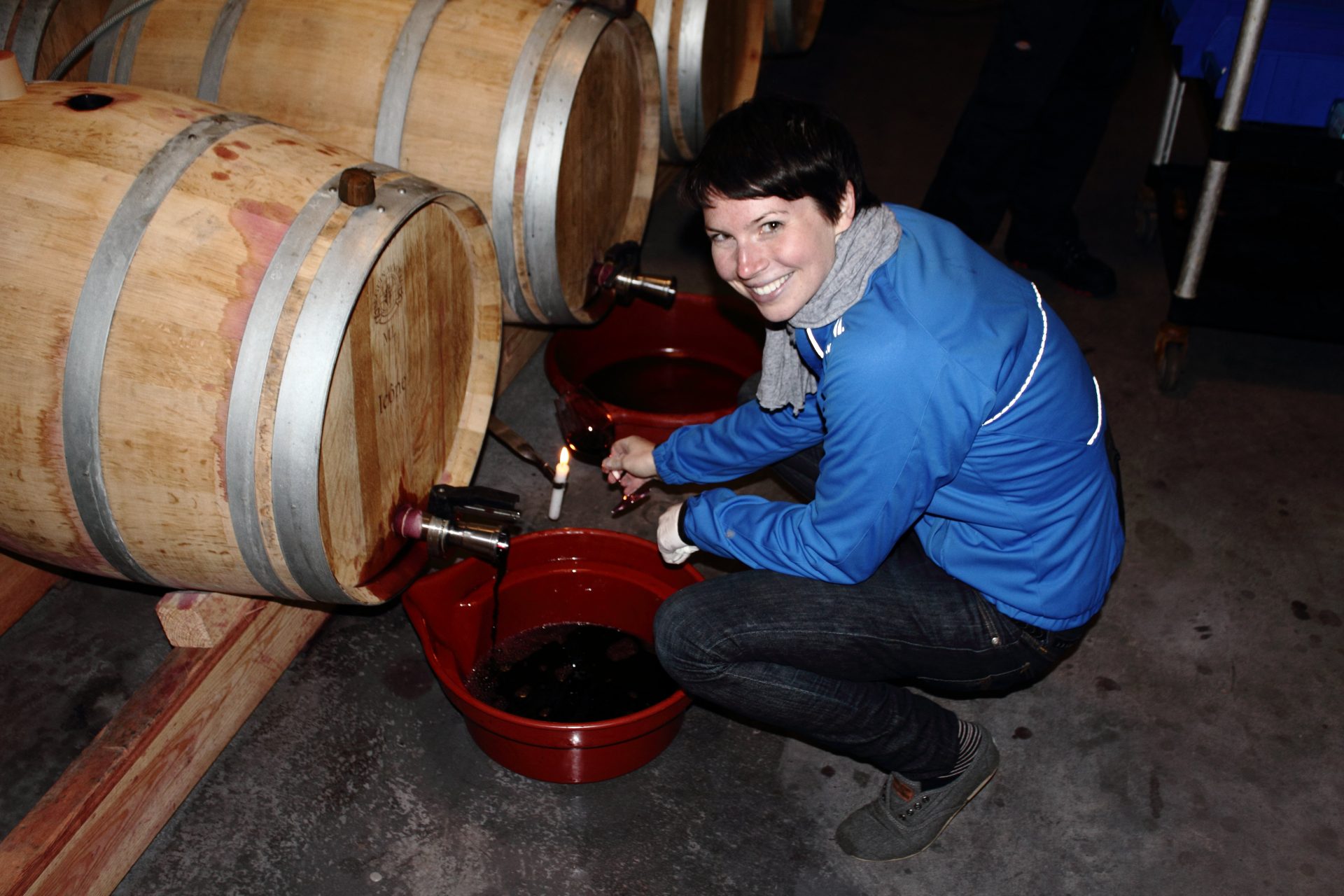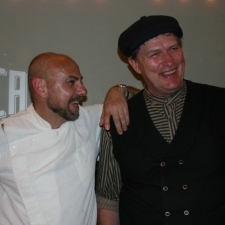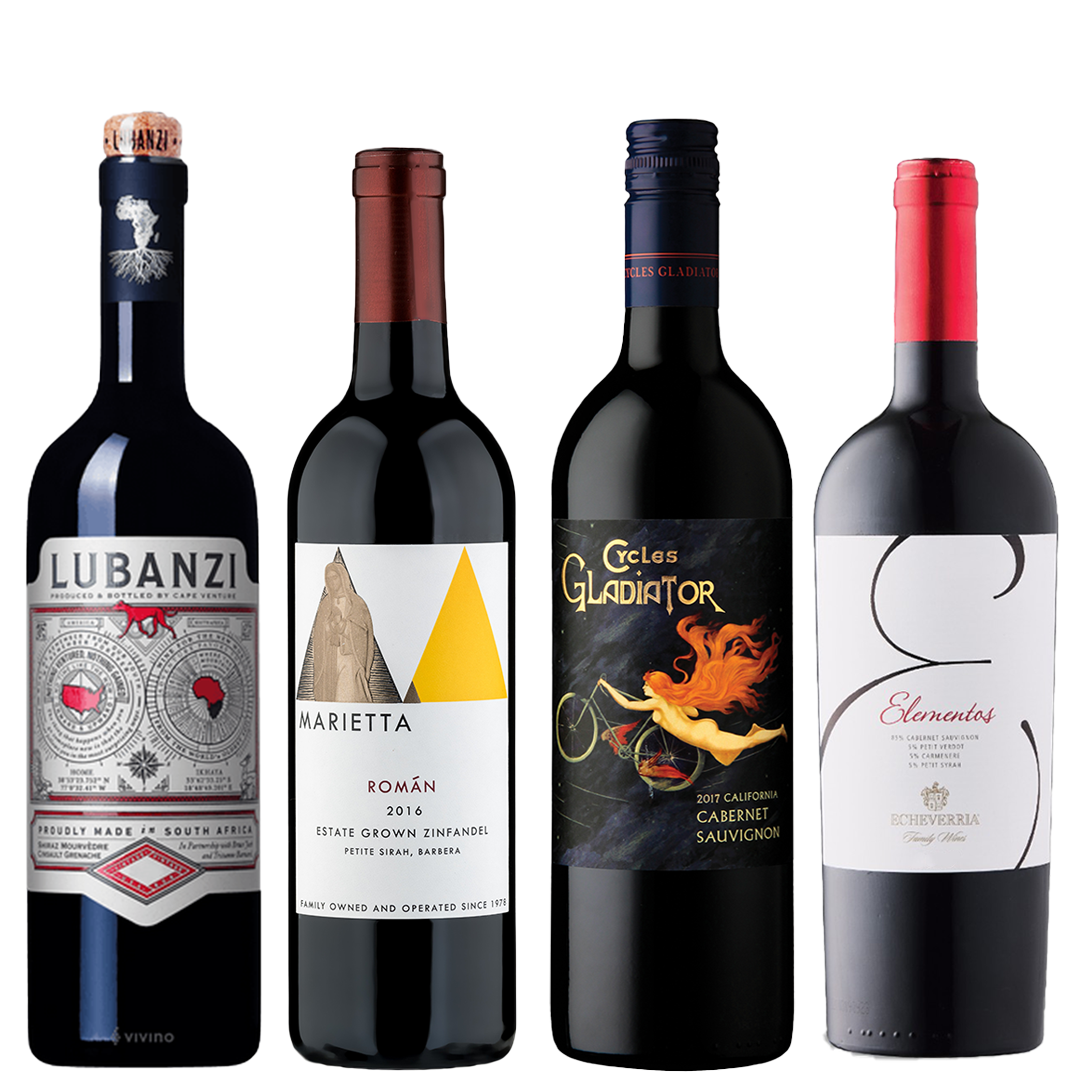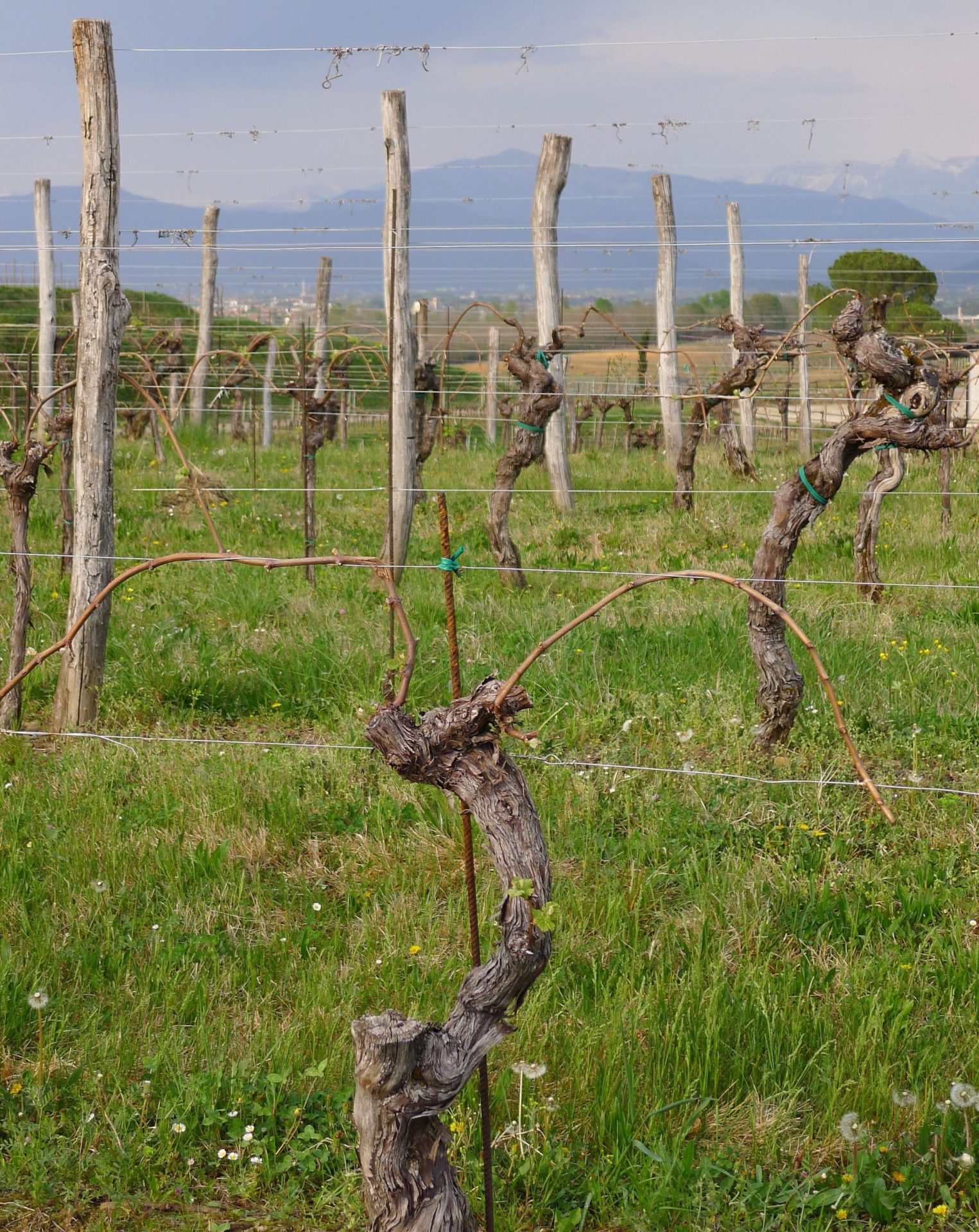By: Nicole Campbell
This week the other Compagnie Medocaine stagiaire and I were lucky enough to spend a full day working and touring Château Pichon-Longueville, second grand crus classés of Bordeaux located in Pauillac.

Les stagiaires! Remi & me ready to work.
A typically dreadful morning of Bordeaux traffic, the winery was already buzzing by the time we arrived. We met up with Jean-Rene Matignon, the technical director of Pichon Baron since 1985, who welcomed us warmly and began our tour.
It is telling to tour a winery in the throws of harvest. Floors are wet, grape stems peep out of buckets, and the smell of freshly fermenting grapes wafts through the air. Beyond the sights and sounds of harvest, there are also people hard at work. Typically on non-harvest days you may see one or two faces on a winery tour, the pace slow and civilized. In harvest the excitement and stress of vintage is palpable, a year of work in the vines culminating in a high-pressured few weeks of picking and fermenting. In harvest the château’s character hangs loosely on its sleeve.
We began with the sorters. Sorting is an incredibly important part of harvest. Even the most fastidious pickers will pick some grapes better left excluded from the wine: shrivelled berries that are tart, molded grapes that are bitter or other debris like leaves and stems. At Pichon there are two methods of sorting. The first is traditional, by hand. A first group of sorters picks through whole bunches, discarding unripe or unhealthy sections before they reach the destemmer. After being destemmed grapes are individually sorted. A team of 6 watch grape by grape bounce by, grabbing suspicious berries before they roll on to fermenting vats. The Pichon sorters were extremely careful, but also possessed a joyfulness I do not think I would be capable of with such painstaking manual labour. They laughed and joked and smiled at my accent, Canada! they exclaimed.

Individual grape sorting.
The second method of sorting is a new technology, the laser sorting machine. This machine individually analyzes each grape, disregarding any flawed grapes with scientific precision. Still in its early phases at the Château, Pichon is doing comparisons between the hand-sorted and machine-sorted grapes at various processes of winemaking. The machine is undeniably more accurate and perhaps the romantic old days of grapes bouncing by a table of watchful eyes are numbered.

The digital sorter analyzing each grape.
We continued our tour in the cellar chamber. Encircled by ceiling-high stainless steel tanks we watched as wines were “pumped over”. Juice gushed into large bins before being transported to the top of vats where the ‘cap’ or collection of grape skins awaited, ready to give the juice colour, tannin, and flavour. This year, on account of the dry season in Bordeaux, grape skins are thicker. Pichon is cautious of over-extraction; colour, tannins and flavours of grape skins are essential, but too much results in over-tannic, brash wine lacking all elegance and finesse.

The tanks at Pichon.

the beautiful red of freshly pumped over juice.
Pump-overs are carefully managed and logged, each tank’s juice tested daily by machine and by hand to monitor alcohol, temperature, acid, sugar and more geeky terms I didn’t learn in French class. (The joys of life in a second language). The logs are then entered into excel spread sheets where they are compared to past vintages, putting numbers behind taste profiles, learning from each years choices. The statistician in me yearned to have my way with the spreadsheet, correlating different journalists scores to the detailed factors in the log. A fascinating study, for a future day…

Fiche de Remontage or Pump-Over Log.
The next stop on our tour was the barrel room. The famous 09 vintage aged in barrel as stacks of new oak waited the 2010 vintage- Pichon uses 40% new oak barrels per year. Two Pichon stagiaires were busy fining the 09 barrels and Jean-Rene left us to work with them till lunch. As wine ages in barrel it develops sediment- although perfectly safe to drink, people don’t want to pour a bottle of wine swirling with grapes solids.

Sediment from the 09 barrels.
Sediment can be fined out of the wine through a variety of methods. Wineries are increasingly fining with the help of technology, but Pichon still fines traditionally, with egg whites and a candle. We added 90 mL of egg-whites to each barrel and attached a machine that mixed it into the barrel.

egg white mixture and trusty beaker.
The egg whites cause the sediment to collect, making it easier to see. We then transferred the wine from one barrel to another, the last of the barrels contents tipped out slowly by one person, as the second, with the help of a candle and a glass, watched for sediment. At the first sign of sediment we closed the funnel, the sediment-filled wine transferred to separate barrels.

Me with my glass and candle.
After fining, we rolled the now-empty barrels to be cleaned by a special machine which scours them with hot, then cold water, killing all bacteria. As we were told throughout the day, it takes a lot of water to make good wine, any type of bacteria growth capable of adding unattractive characteristics to the bottle. Rolling a barrel is easier said than done and the cellar echoed with laughter as I awkwardly struggled. The trained cellar rats swapped stories of their first vintage and showed us an alternative method of barrel rolling for newbies. Instead of angling and spinning the barrel on its edge, the second method of pushing with brute force is equivalent to barrel curling. I tried to use the mop to sweep the barrels path, but we needed the ice of Canada for the sport to truly take off. (this just may be my million dollar idea).
We moved from barrel to barrel, sampling the delicious 09 vintage between fining- for quality control purposes, clearly- and all of a sudden it was 1 pm, time for the communal lunch. In the tradition of the old châteaus, Pichon serves lunch to all its harvest employees: from pickers, to sorters, to cellar hands to office clerks. We squeezed into the massive table across from Jean Rene as we were brought an amazing feast. We started with what they call a salad, but was more accurately savoury meat with a leaf of lettuce. Regardless, it was delicious. Next came big, family style bowls of stew: hunks of brisket, cabbage, potatoes and carrots bathed in rich broth passed from earth-stained hand to hand. Unlabelled bottles of wine spotted the table, after which 04 Pichon-Longuville magically appeared (yum!). In typical French style, lunch was relaxed and spirited. After the stew came plates full of 5 or 6 different cheeses, as the kitchen staff offered ripe pears. Diners emptied their glasses of wine and filled them with piping hot coffee, water condensing on the glasses edges. “It’s the first time I’ve seen that”, I said, in timid French, to a picker, “coffee in a wine glass”. “What else would be drink it from?”, he replied with a chuckle.
After lunch we toured the vineyards with Jean Rene. We drove past the vineyards of Pichon-Longueville, but stopped in the vineyards of Château Pibran, which Pichon vinifies as well. The team of Spanish pickers were fast and impressive to watch.

picking merlot.
As excellent pickers are hard to find, most chateaus in the area work with a recruiter who finds experienced groups of seasonal workers for the job. The recruiters bus them into town and the chateaus take it from there, providing lodging, meals and transport for the length of their stay. Often groups of families from the same town leave together, the pickers truly a tight-knit village community.

Talent.
When we arrived they were picking merlot from the organic section of the vineyard. Jean Rene explained the rationale and struggles with the bio area. Although they never plan on farming the entire vineyard organically, they are interested in seeing the effect of organic viticultural on the health and taste of the grapes. They started three years ago, first spraying with compounds meant to help the vines be stronger and more susceptible against disease. The results were disastrous, over half of the crop discarded due to poor quality. This year they have tried a new approach, using a different set of sprays. The results have been much more promising. “It’s ironic”, Jean Rene explained, “people hear organic and they automatically think good for the earth, less spraying, but sometimes it’s exactly the opposite.” Organic farming requires twice the spraying of its chemical counterparts. “We’re still spraying, but just spraying with organic things that are half as effective, some of them, like copper, are not good for the soil”. “So why do it?”, I asked. “In France we need more agricultural research. Research with commercial sprays are funded, but nothing else. To learn we do our own tests.” And doing their own tests they are. The organic grapes look healthy and tasted ripe and flavourful. Some leaves were dusted with mildew, but the grapes were unaffected. We looked for botrytis in the late ripening patch of the vineyard still waiting for a few more days of warmth before picking, but found only a few affected grapes. Surely a good sign for the 2010 vintage.

Spanish harvesters resting.
We drove back to the château, Jean Rene pointing out famous, neighbouring vineyards. We drove by Mouton-Rothschild, whose vines touch Pibrans, talked biodynamics, as we passed the only biodynamic vineyard in the area, Pontet-Canet, and drove through the town of Lynch-Bages. Arriving back at the vineyard there was only one thing left to do, taste. On the way we stopped in the wineries cellar where they keep a selection of wines from famous millisimes. These wines are reserved for special winery functions, a larger selection of wine kept elsewhere to analyze its development over time. The oldest wine in the cellar is this bottle from 1907, unfortunately not part of our degustation.

1907 Pichon-Longueville.
The tasting itself was a true pleasure. We started with the 2009s tasting through the wineries selection: Chateau Pibran, Tourelles de Longueville (the second Pichon wine) and finally the hallmark wine, Pichon-Longueville. We finished the tasting and were chatting, when Jean Rene paused, “we need to taste older vintages, don’t you think?”. Our wide eyes gave away our enthusiastic support. We tasted the 08, 07 and 06 Pichon-Longueville, each vintage with its own unique taste profile, but all with an hallmark elegance and structure.

The ending of a great day: tasting with Jean Rene.
I left the winery with a giant smile. Pichon is truly a spectacular winery run by passionate, fiercely smart people doing everything they can to make the best wine possible. There will be a bottle in my suitcase.
bee for Lifford Wine Agency,
Ontario’s largest supplier of wine to the hospitality industry. Currently
living in Bordeaux, getting first hand experience as a stagiaire for
negotiant Compagnie Medocaine. Follow her on twitter @liffordnicole.








Trackbacks/Pingbacks